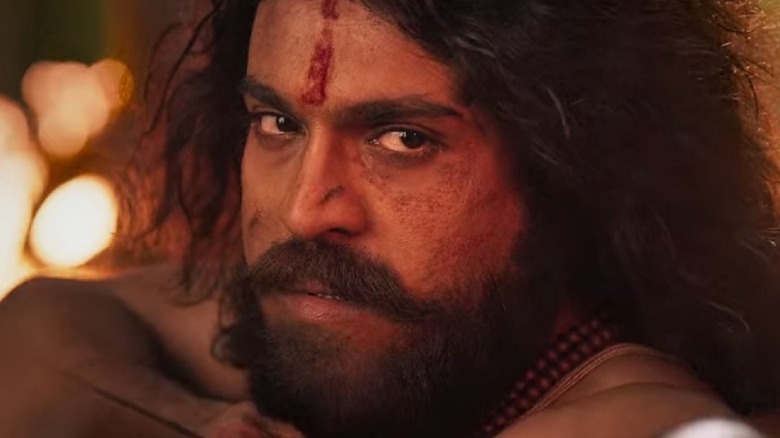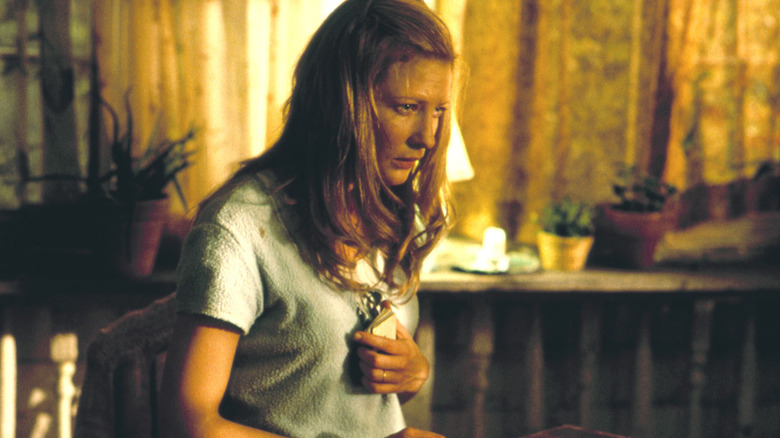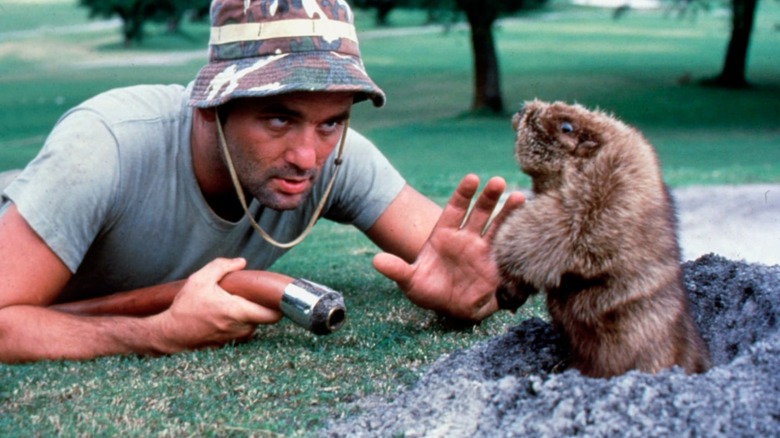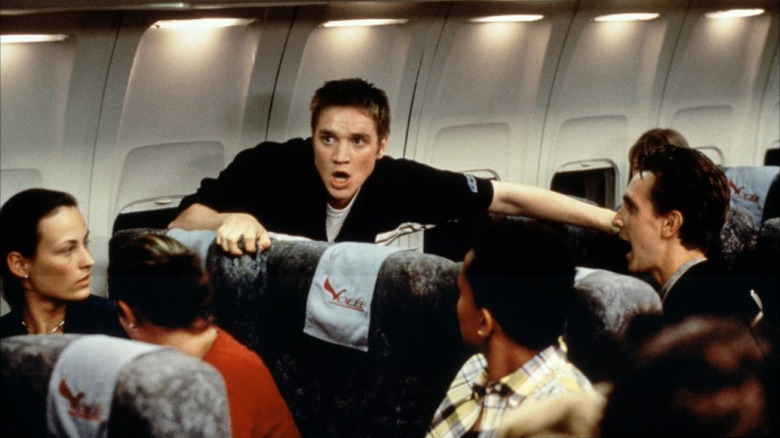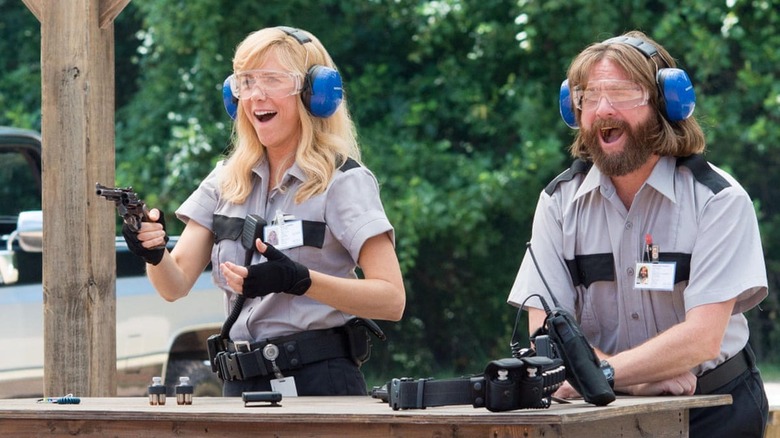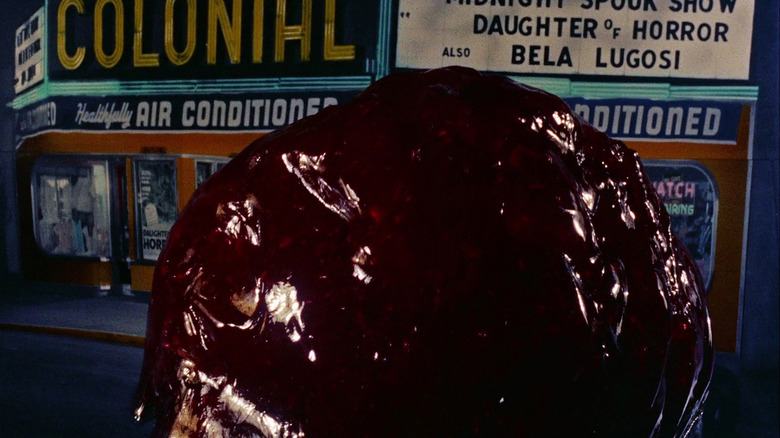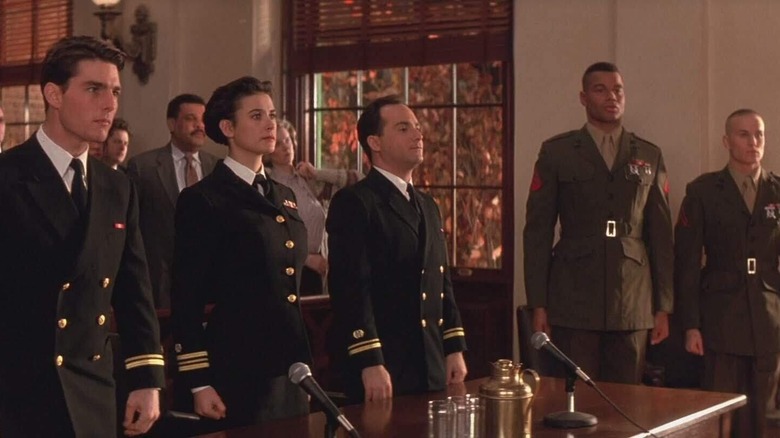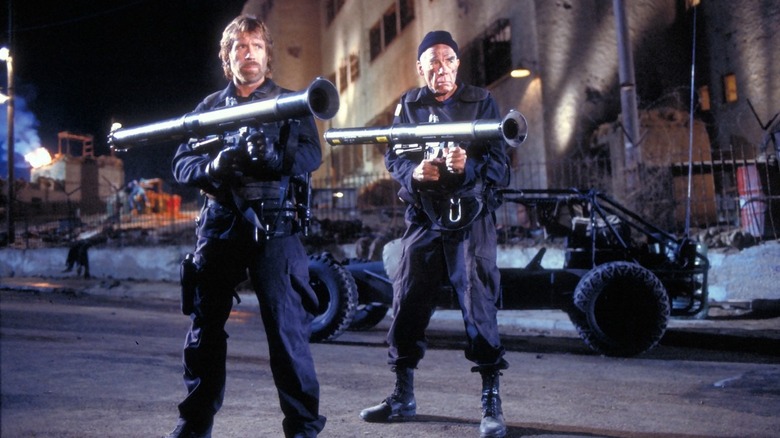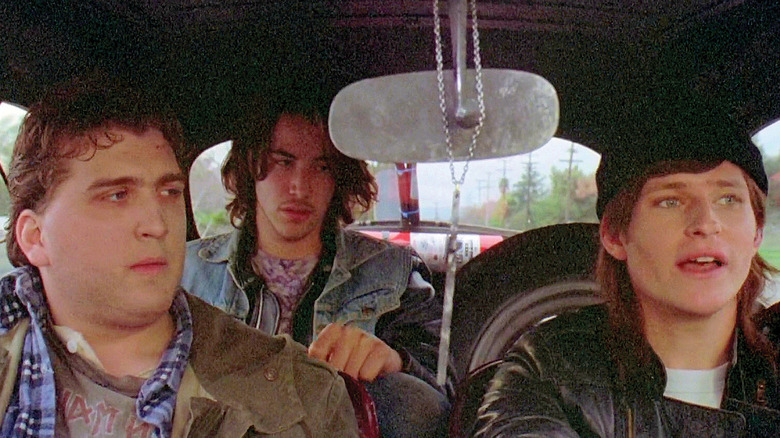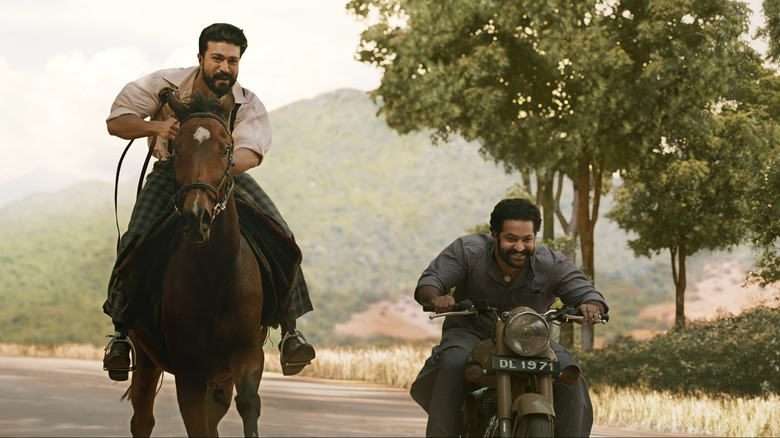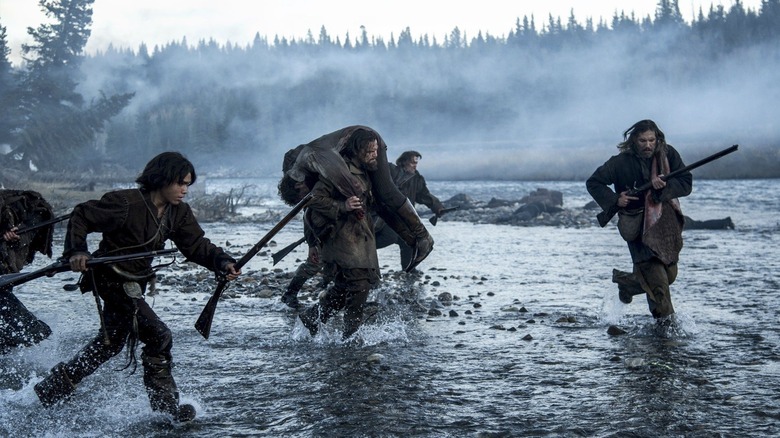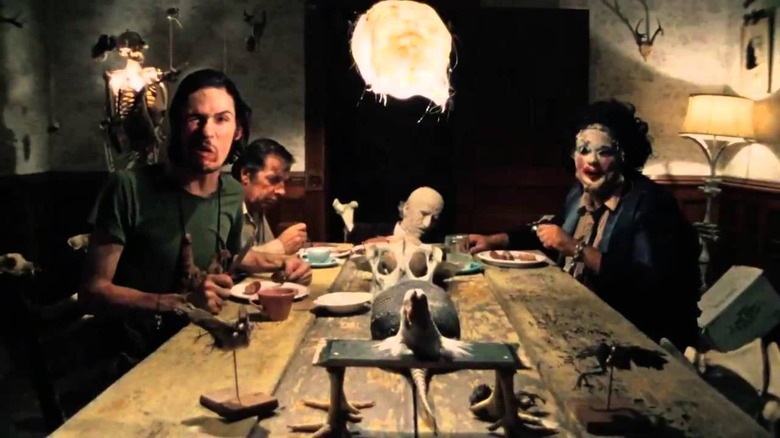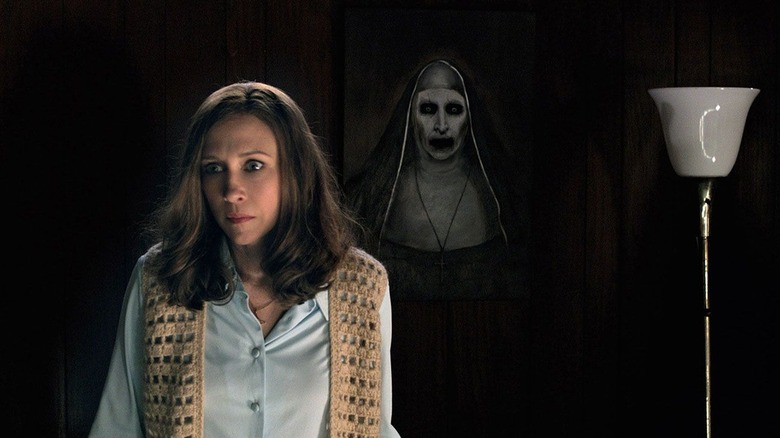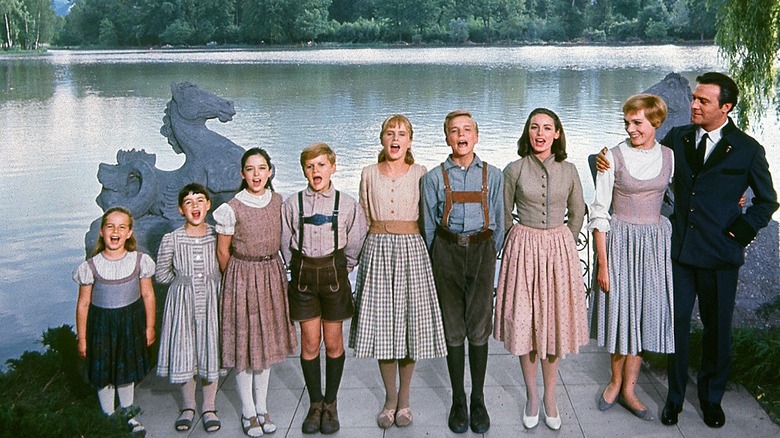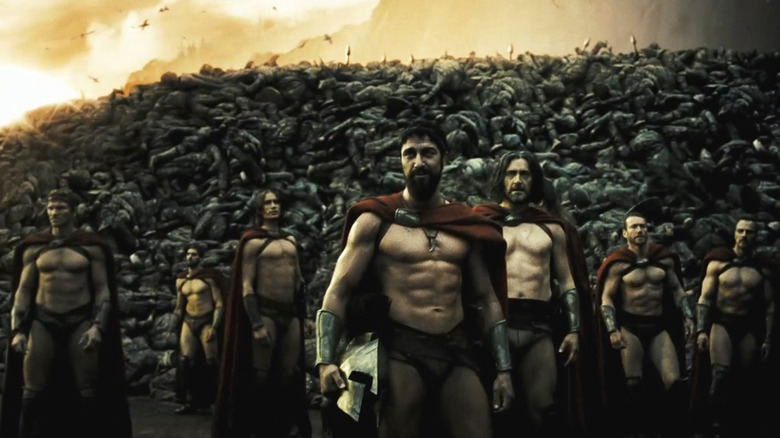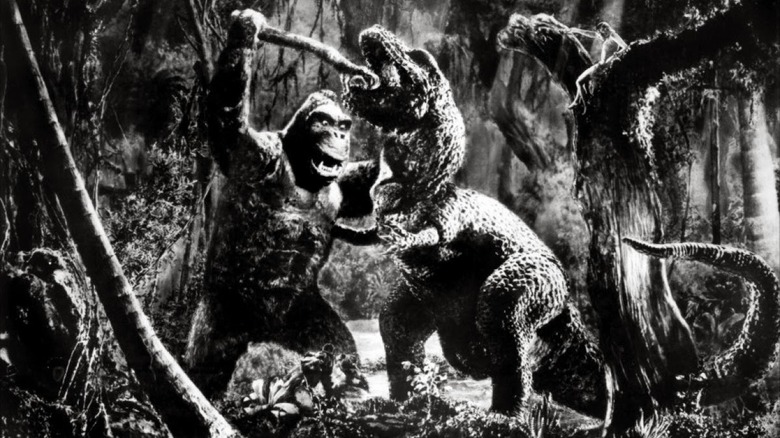Movies You'd Never Expect To Be Based On A True Story But Are
For the entertainment industry, art imitating life has been a time-honored tradition. The notion of taking interesting real events and adapting them for the silver screen is something studios often find irresistible. Some of the oldest blockbusters Hollywood ever churned out were historical epics based on ancient wars and personalities like Cleopatra and Julius Caesar.
Moving into modern times, "based on real events" films started getting more intimate, focusing on the personal lives of revolutionaries like Mahatma Gandhi or mathematician John Nash, and winning bucket loads of awards in the process. Other times films like "Titanic" chose to present historic events in a larger-than-life fashion while still hewing reasonably close to the actual chain of events.
But not every movie based on real events is concerned with sticking strictly to the facts when making the jump to the big screen. In fact, some films feature such strange and unusual storytelling that it is difficult to believe they are supposed to be based on reality. Let us take a look at some such "based on real events" movies that play fast and loose with the reality on which they are based.
The Gift (2000)
Sam Raimi is a filmmaker who has made his entire career on the backs of wildly over-the-top and entertaining horror and action films. Whether helming the original "Evil Dead" movie or bringing the first modern live-action version of Spider-Man to the big screen, Raimi infuses all his works with a preposterous energy that looks like it belongs to a different, more colorful dimension.
That is why the filmmaker feels like an odd choice for "The Gift." The horror movie certainly seems like it should be right in Raimi's wheelhouse, but unlike the zany theatrics of "Evil Dead," "The Gift" is supposed to be based on real events. Billy Bob Thornton, best known for his acting roles, co-wrote the film based on the psychic experiences of his mother. "My mom was a psychic," Thornton told The Hollywood Reporter in 2014. "There's a movie called 'The Gift' that I'd written years ago with Cate Blanchett, which is loosely based on my mom."
In the film, Thornton's mother takes the shape of Annie, played by Blanchett. After receiving some unexpected psychic visions, Annie finds herself being drawn into the orbit of an unsolved murder case and feels compelled to help the police clear up the matter. "The Gift" was a modest success at the box office and drew praise from critics for the performance of the main cast and Raimi's uncharacteristically low-key direction style.
Caddyshack
The '70s and '80s are generally considered the golden age for gritty, realistic cinema in Hollywood. But what is often overlooked is that the era was equally golden for smart, mid-budget comedies headlined by rising stars of the genre. One of the most iconic films of that era is the sports comedy feature "Caddyshack."
One of the hottest comedy stars of the time was Chevy Chase, and Bill Murray was fast catching up with him in terms of popularity. The duo bounce off each other well in "Caddyshack," with Chase playing enthusiastic golfer Ty Webb, and Murray essaying the role of the unbalanced greenskeeper Carl Spackler who works at the golf course where Webb plays. The movie sees Webb, Spackler, and other characters run riot around the golf course with a series of slapstick gags and jokes.
While it seems hard to believe the events shown in "Caddyshack" could happen in a real country club, the movie is based on experiences that Murray and his brothers had while caddying at the Indian Hill Golf Club in Winnetka, Illinois, as teenagers. "Over the years, I've told people that I was the real Danny Noonan," Murray's late older brother Ed stated in an interview reported by Entertainment Weekly. "Many of the events in 'Caddyshack' I experienced during the many years I served as a caddy at Indian Hill Club."
Final Destination
Slasher horror movies are well-known for going to bizarre lengths to create the next iconic slasher horror villain, whether it is an undead monster like Jason Voorhees or Freddy Krueger. But the "Final Destination" franchise has taken the idea of a powerful and fearsome slasher horror villain to a whole new level.
The "Final Destination" franchise explores the idea of the literal concept of death acting as a slasher killer, coming up with gruesome ways of taking down characters who somehow previously managed to cheat death. The series sees its main cast of characters being stalked by the invisible but ever-present death until they find themselves losing their lives through a series of horrifying "accidents." The franchise kicks off with the first "Final Destination" movie, which features a plane crash that the main characters manage to narrowly avoid.
The circumstances of the crash were directly inspired by the tragedy of TWA Flight 800, which crashed into the Atlantic Ocean on July 17, 1996. "Final Destination" actually borrows real-life footage from the wreckage of the crash and its aftermath, a fact that rubbed at least one person involved with the movie the wrong way. "There was some criticism that the movie was written to exploit this real-life crash," franchise creator Jeffrey Reddick recalled in an interview reported by Den of Geek. "I even realized later they used footage from one real-life crash, which I wasn't particularly happy about."
Masterminds
Comedy is a genre that can get pretty fanciful at times, but every good piece of comedy is grounded in some sort of human experience. For the crime comedy film "Masterminds," the inspiration from real life is obvious. The movie follows the exploits of a group of current and ex-employees of Loomis Fargo & Company as they decide to rob the corporation of millions of dollars.
Despite some fumbles along the way the plan succeeds, and it is not long before the FBI is hot on the trail of the would-be criminals. With an all-star comedy cast that includes Zach Galifianakis, Owen Wilson, Kristen Wiig, Kate McKinnon, Leslie Jones, and Jason Sudeikis, "Masterminds" is far wackier and over-the-top than its "Ocean's Eleven" premise might make you believe.
This is despite the fact that, unlike the "Ocean's" franchise, "Masterminds" is based on a real-life incident — namely the October 1997 Loomis Fargo robbery in North Carolina. In fact, one of the people involved in the robbery, David Ghantt, served as a creative consultant for thttps://wp.looper.com/wp-admin/submission-detail.php?a=315182#he film. Unfortunately, even its comedic star power and the fascinating true story it was based on could not save "Masterminds" at the box office.
The Blob (1958)
The main question that most horror filmmakers have to ask themselves right at the start of a fresh project is how they can create a compelling new villain. Sometimes this involves giving the character a distinctive and scary appearance that produces chills in audiences with a single glimpse. Other times, as was the case with "The Blob," the makers decide to go in the opposite direction.
In a small Pennsylvania town in the 1950s, a meteorite crashes into a hill at night. When a man goes to investigate the alien object, a gelatinous, shapeless creature emerges and fastens onto the man. This is the titular "Blob," and over the course of the movie, it jumps from one victim to another, killing and absorbing their nutrients and growing in size until it threatens the safety of the entire town.
The look and feel of the main creature from "The Blob" are said to have been inspired by the appearance of a star jelly that showed up in Pennsylvania in 1950. The star jelly's alien appearance was described as "a domed disk of quivering jelly, six feet in diameter, one foot thick at the center and an inch or two near the edge," a description that also applies pretty well to the Blob. The success of the movie spawned an unlikely franchise filled with characters running away in terror from what appears to be a slowly moving tub of lard.
A Few Good Men
In the late 1980s, Tom Cruise was considered the golden boy of militaristic cinema thanks to the success of "Top Gun" in 1986. But then Cruise chose to go in a radical new direction with "A Few Good Men," a movie that depicts the underbelly of the world of soldiers and the military.
Cruise stars as Lieutenant Daniel Kaffee, a lawyer in the U.S. Army who is handed a case concerning the death of a marine at the Guantanamo Bay Naval Base in Cuba. There is a suspicion that the death was the result of a "code red" order issued by base Commander Colonel Nathan Jessup (Jack Nicholson), and it is up to Kaffee to prove the charges against Jessup despite resistance from the army to investigate the matter further.
Before being adapted into a movie, "A Few Good Men" was a stage play written by Aaron Sorkin. The celebrated screenwriter got the idea for the play after a telephone conversation with his sister Deborah, who was working as a lawyer for the Navy Judge Advocate General's Corps. During their talk, his sister told Sorkin about a case she was working on in which a bunch of marines hazes a newcomer almost to death, and the whole thing was said to have taken place on the direct orders of a superior officer. Shortly after the conversation, Sorkin said in an interview that he "grabbed a couple of cocktail napkins off the bar and began writing 'A Few Good Men.'"
The Delta Force
Action movies from the '80s were famous for not letting realism get in the way of over-the-top bottom-kicking, where a single muscled and well-oiled hero takes on a storm of enemies and hacks them down in short order. Chuck Norris is a prominent hero of that era, and his starring vehicle "The Delta Force" is exactly what you would expect from a Norris film.
Major Scott McCoy, played by Norris, is a retired U.S. Delta Force operative. Although burned out from dealing with politicians and diplomatic red tape, McCoy has no choice but to return to the field when a group of Palestinian terrorists hijacks a Boeing 707 traveling from Cairo to New York. With time running out, McCoy quickly draws up a plan with his fellow Delta Force operatives to infiltrate the enemy's stronghold and kill everyone and everything that stands in their way.
Starring an able cast of actors supporting Norris, "The Delta Force" draws inspiration from two real-life incidents: the hijacking of flight 847 by a group of fundamentalist terrorists and Operation Entebbe, which was a counter-terrorist hostage-rescue mission undertaken by members of the Israel Defense Forces at Entebbe Airport in Uganda on July 4, 1976.
River's Edge
Imagine making a movie considered too extreme for 1980s Hollywood. Also imagine making a movie that is technically a crime drama, but gets described as more of a horror movie due to the disturbing nature of its content. Both these things happened with director Tim Hunter's feature film project "River's Edge" when it came out in 1986.
The local teen and pre-teen population in a Northern California town is swept up in the secret news of one of the local delinquents murdering his girlfriend and stashing her body in the forest. Instead of exposing the crime, the teens close ranks around their peers, helping him get rid of the body and lying to the police about the matter of the missing girl.
More than the crime itself, it is the apathetic attitude of the youths towards the murder of the young girl that makes the movie so horrifying. Unfortunately, the gruesome story has some basis in fact, since "River's Edge" was partly inspired by the murder of Marcy Renee Conrad in 1981 by high schooler Anthony Jacques Broussard. Much like in the movie, news of Marcy's murder spread around the local youth population, and they attempted to cover for the killer out of some twisted desire to not be seen as the snitch who "ratted out" the whole thing to the police.
RRR
Indian cinema is something that viewers in the West have long been aware of but kept at arm's length due to the movies being perceived to be overlong and filled with unnecessary song-and-dance sequences. But the Telugu cinema (Tollywood) action epic "RRR," also known as "Rise Roar Revolt," helped buck that trend by making a huge impression on western critics and audiences.
In the 1920s, during India's occupation under the British empire, a man called Bheem (N. T. Rama Rao Jr.) sets out from his local forest area to rescue a little girl belonging to his tribe who had been taken to Delhi by a powerful British family. Warned of Bheem's approach, the British enlist the help of local officer Raju (Ram Charan), who has his own agenda behind siding with the Empire over his own people.
Imagine the most gloriously over-the-top Hollywood action movie you have ever seen, and multiply that by 100 to gain some understanding of the chaotic grandeur of "RRR," which includes Bheem facing off against a literal tiger, a menagerie's worth of animals attacking British soldiers, a breath-taking dance-off sequence with the very honor of Indian culture at stake, and Bheem and Raju combining to morph into Goro from "Mortal Kombat." Despite the liberties taken with the action and storyline, director S.S. Rajamouli was inspired by the real-life exploits of Indian freedom fighters Alluri Sitarama Raju and Komaram Bheem.
The Revenant
Leonardo DiCaprio is not really known for being an action star, but that did not stop him from playing the lead role in "The Revenant," director Alejandro G. Iñárritu's magnum opus about the unforgiving life of a frontiersman in the 1800s, where it's not just humans that are actively trying to kill you, but mother nature itself.
DiCaprio plays the role of Hugh Glass, a frontiersman who is helping a group of trappers finds their way through the territory of the present-day Dakotas. A series of misfortunes leave Glass seriously injured, and his son murdered by one of the trappers named John Fitzgerald (Tom Hardy). Left to die in the frozen wilderness, Glass has no choice but to undertake a tormenting journey back home with his burning desire for revenge against Fitzgerald sustaining Glass through constant near-death experiences.
"The Revenant" earned DiCaprio his first Academy Award for a role. On the difficulties of playing Glass, the actor told Yahoo, "I can name 30 or 40 sequences that were some of the most difficult things I've ever had to do," including eating raw bison liver and sleeping in an animal carcass. The movie was directly inspired by Michael Punke's 2002 literary work "The Revenant: A Novel of Revenge," which was itself based on the experiences of real-life frontiersman Hugh Glass.
The Texas Chainsaw Massacre (1974)
Few movies have impacted their genre as much as "The Texas Chainsaw Massacre" impacted the slasher horror genre. The movie is responsible for many of the tropes that you see in slasher films today, in addition to giving the world one of the most iconic slasher villains of all time in the shape of the chainsaw-wielding maniac Leatherface.
And yet, the movie was not initially designed to be a typical slasher horror. When director Tobe Hooper co-wrote the screenplay with Kim Henkel, they were following the blueprint of movies like "Psycho" and "The Silence of the Lambs," which are more interested in exploring the psyches of killers than piling up the body count. In their creation of the world of Leatherface and his deranged, cannibalistic family, Hooper and Henkel looked to real-life murderers for inspiration.
"I definitely studied [Ed] Gein," Henkel explained to Texas Monthly (via Yahoo). "But I also noticed a murder case in Houston at the time, a serial murderer you probably remember named Elmer Wayne Henley." Gein, of course, was one of the most infamous serial killers in the world, known for keeping skin and bone trophies of his victims. This became the founding characterization of Leatherface in Hooper and Henkel's film, and the basis for the character's famous face mask.
The Conjuring franchise
"The Amityville Horror" is one of the most famous horror movies that claim to be based on real events. In the real world, Ed and Lorraine Warren were a husband-and-wife paranormal investigator team that was associated with the incident at Amityville, as well as various other cases of hauntings and exorcisms across America.
The cases handled by the Warrens, and their museum of haunted artifacts that they established across several years of their careers became the basis for "The Conjuring" franchise with the release of the first movie in the series in 2013. Patrick Wilson and Vera Farmiga play the roles of Ed and Lorraine, who make use of Lorraine's ability to communicate with the spirit world to offer help to families being troubled by hauntings and ghostly visitors.
Many of the villains seen in "The Conjuring" franchise are said to have some basis in reality, like the cursed doll Annabelle, the ghost of the witch Bathsheba Sherman, and the character in "The Conjuring 2" based on the Enfield poltergeist. Of course, most of the events depicted in the series are based on supernatural claims made by the Warrens and cannot actually be confirmed in a scientific manner.
The Sound of Music
"The Sound of Music" is one of the most iconic Hollywood musicals of all time. It made a star out of its leading actress Julie Andrews in the role of a free-spirited young woman named Maria who is tasked with caring for and teaching the children of the wealthy but strict Captain Georg von Trapp (Christopher Plummer). The movie's bright songs, characters, and setting are considered comfort food for many viewers.
Yet, the circumstances behind the creation of the movie were not nearly as sunny. It all began with a 1949 memoir written by Maria Augusta von Trapp titled "The Story of the Trapp Family Singers." The book tells the tale of the von Trapp family, who lived in Salzburg, Austria, before being forced to flee Europe due to the Nazi invasion, making their second home in America as a singing and dancing variety act.
Many of the incidents mentioned in the memoir are adapted directly for "The Sound of Music." But there are several key differences as well, like how in the book the father is not a stern and aloof parental figure, and his marriage to Maria takes place several years earlier.
300
Zack Snyder is a filmmaker well known for "muscular filmmaking," and no movie better fits that description in the history of cinema than the 2006 feature "300." Based on a comic series by Frank Miller and Lynn Varley, the movie takes place in 479 B.C. and tells the story of the Spartan empire.
The Persian God-King Xerxes (Rodrigo Santoro) has arrived in the land of Sparta along with his massive army and demands the subjugation of Leonidas (Gerard Butler), King of Sparta. Unwilling to bend the knee before the foreign invader, Leonidas embarks on a campaign along with 300 other Spartan warriors. Their plan is to funnel the Persian army into a narrow opening between land and sea and pick off their enemies one by one.
The events surrounding the actions of Leonidas and his men are based on the historical Battle of Thermopylae, but many if not most of the details surrounding the incident are highly exaggerated in the comic and film adaptation, like the fact that the actual number of soldiers led by Leonidas numbered in the thousands rather than only 300.
King Kong (1933)
Most genres of cinema, from drama to comedy to horror, can lend themselves to adapting real-life incidents that have happened to people in the real world, but the monster movie genre seems exempt from this rule since it deals with larger-than-life creatures and hundreds of feet tall monsters who obviously have no basis in reality.
And yet so many of them do. The original "King Kong" movie tells the story of a group of explorers coming across an island that contains giant lizards and an equally huge ape-like creature. While Kong was basically a bigger version of real-life gorillas as imagined by director Merian C. Cooper, the island full of giant lizards also has a basis in reality, being inspired by W. Douglas Burden's book "The Dragon Lizards of Komodo."
Even the mythology of King Kong's iconic cinematic frenemy Godzilla was directly inspired by the atomic bomb that was dropped on Hiroshima and Nagasaki. Meanwhile, Steven Spielberg kickstarted the whole "giant shark wants to eat everything in the sea" genre with "Jaws," which was inspired by a series of shark attacks in the real world.
